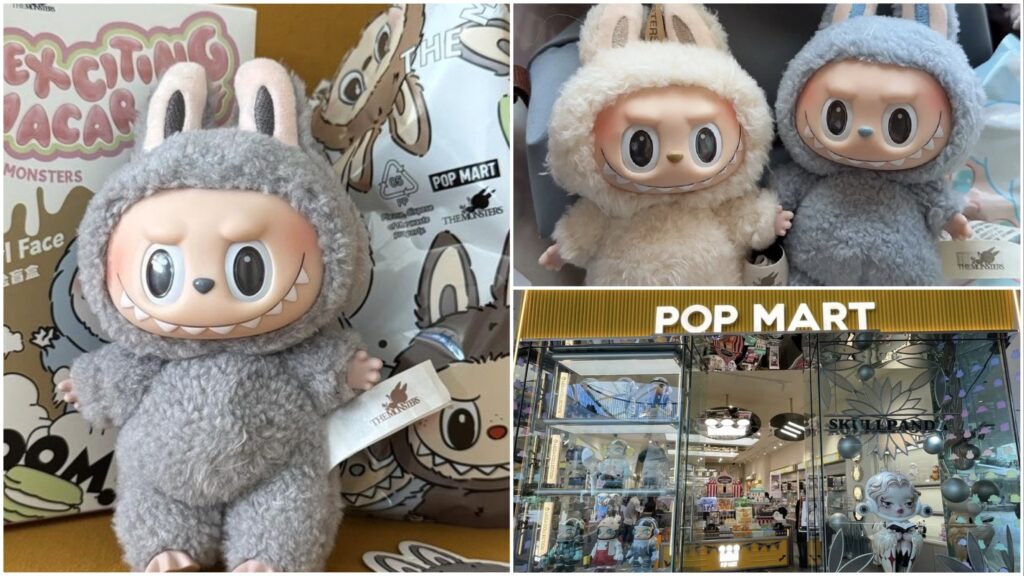On a drizzly Saturday in Tokyo, someone cracked open a fresh Labubu box expecting that familiar “ugly-cute” grin, only to find lopsided ears, paint that smelled like a bad nail salon, and a logo that looked like it had been printed during a blackout. Heart. Sunk. That wasn’t a Labubu. That was a Lafufu.
Before you accidentally add an impostor to your shelf, here’s your complete, no-boring-bits guide to spotting the real deal.
Labubu vs. Lafufu
Labubus are part of the Pop Mart family. They are tiny, bug-eyed misfits with toothy grins that somehow melt hearts. They’re so ugly, however, charming; the kind of charm that sells out in minutes.
If you’ve hunted for months to find one, the last thing you want is a Lafufu smiling back at you.
A Lafufu? That’s the knockoff cousin no one invited to the party. Cheap plastic, awkward smile, and none of the magic. And in the Labubu vs. Lafufu game, knowing the difference can save your wallet and your pride.
Why Spotting the Difference Feels Personal
It’s not just about paint and plastic; it’s about that spark. Real Labubus have a weight, a finish, and a presence that makes you grin every time you walk past your shelf. But the fakes? They feel wrong. Flimsy. Lazy. Some even have a mystery odor that makes you wonder what on earth they were made from. If you’ve hunted for months to find one, the last thing you want is a Lafufu smiling back at you.
Packaging: The First Clue
Think of Pop Mart boxes as tiny art pieces. Sturdy cardboard, glossy finishes, colors that pop, and text so sharp you could almost cut yourself on it.
But the fakes look like they’ve been photocopied on a tired office printer. Blurry edges, dull colors, and the occasional typo that makes you squint. Before you even touch the toy, read the box like a detective; half the story is on the outside.
The Feel Test: Your Hands Don’t Lie
Pick one up. A real Labubu has a balanced, satisfying weight like a small, weirdly adorable paperweight. Textures feel deliberate: smooth skin where intended, tiny grooves in fur or accessories. If the paint wipes off with a swipe of your thumb or it has that sticky, mysterious tackiness, congratulations, you’re holding a Lafufu. Rule of thumb? If it feels off, it probably is.
Genuine Labubus come with clean, crisp Pop Mart markings and logos, usually under the feet or at the back of the head.
Details Don’t Lie—But Fakes Do
Real Labubus have the kind of symmetry and sharp sculpting you’d expect from something this collectible. Every tooth, every ear, every eye is just right. Lafufus? They have quirks that aren’t cute—mismatched eyes, drooping ears, and teeth that look like they’ve been made of chewed gum. Zoom in on seller photos. Compare with official Pop Mart images. Once you’ve seen the real thing, the fakes practically scream, “I’m not invited!”
Markings and Logos: The Toy’s Passport
Genuine Labubus come with clean, crisp Pop Mart markings and logos, usually under the feet or at the back of the head. They’re neat, perfectly spelled, and precisely placed.
Fakes try to copy them but end up smudging, misspelling, or stamping them in the wrong place. If the “passport” looks dodgy, the toy’s citizenship is suspect.
The Company You Buy From Matters
Buy from Pop Mart stores, official online pages, or trusted resellers with solid reputations. Great reviews? Return policy? Proof of purchase? You’re in safe hands.
Random marketplace listing with one blurry photo and no returns? That’s basically a Lafufu vending machine. When it comes to collectibles, trust the seller as much as the product itself.
Price Tags Can Play Tricks
Have you read “Why Expensive Luxury Goods Might be a Scam—and How to Spot It” on our website? If you have, then you already know that a high price doesn’t make a real one.
Some Lafufus wear “luxury” tags just to reel you in. It’s the same trick used in knockoff handbags. Price is not proof. Always check the official retail value before dropping extra cash. Expensive mistakes hurt more.
Keep the Magic Alive
Collecting Labubus isn’t just about stacking bits of painted plastic on a shelf—it’s about the little jolt of happiness they bring, the nostalgia hit, and the weird charm that makes you grin at something so strange.
Spotting the real vs. fake Labubus is part skill, part gut feeling, and a dash of common sense. A true Labubu has that spark you can’t bottle, and a Lafufu can’t fake. So guard it—peek at the packaging, give it a good feel, check the stamps, and stick with sellers who know their stuff.
In the Labubu world, hold only what makes you grin. Trust your gut, check your box, and never let a Lafufu on your shelf.
Your Turn!
Which test will you use first on your next Labubu hunt? Got a funny Lafufu story? Drop it in the comments. Collectors love a good fake-spotting tale.
